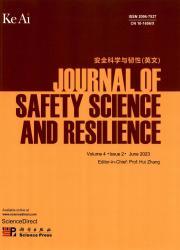DLW-CI: A Dynamic Likelihood-Weighted Cooperative Infotaxis approach for multi-drone cooperative multi-source search
IF 3.4
Q1 PUBLIC, ENVIRONMENTAL & OCCUPATIONAL HEALTH
引用次数: 0
Abstract
Drones have gradually been employed to search for unknown sources during leakage accidents. However, current studies have mainly focused on the single-source search problem, while in practical situations, the location and quantity of the sources are commonly unknown. Existing multi-source search methods fail to accurately estimate the source term, primarily due to the inefficient utilization of concentration information. This limitation results in sub-optimal drone movement strategies. To address these issues, we propose a Dynamic Likelihood-Weighted Cooperative Infotaxis (DLW-CI) approach. The approach integrates the Infotaxis cognitive search strategy with multi-drone cooperation by optimizing both source term estimation and the cooperative mechanism. Specifically, we devise a novel source term estimation method that leverages multiple parallel particle filters, with each filter estimating the parameters of a potentially unknown source in scenarios. Subsequently, we introduce a cooperative mechanism based on dynamic likelihood weight to prevent multiple drones from concurrently estimating and searching for the same source. The results show that the success rate for the localization of 2–4 diffusion sources reaches 90%, 78%, and 42% respectively when employing the DLW-CI approach, achieving a 37% average improvement over baseline methods. Our findings indicate that the proposed DLW-CI approach significantly improves estimation accuracy and search efficiency for multi-drone cooperative multi-source search, making a valuable contribution to environmental safety monitoring applications.
DLW-CI:一种多无人机协同多源搜索的动态似然加权协同信息趋向性方法
在泄漏事故中,无人机逐渐被用于寻找未知来源。然而,目前的研究主要集中在单一来源的搜索问题上,而在实际情况下,来源的位置和数量通常是未知的。现有的多源搜索方法无法准确估计源项,主要原因是对浓度信息的利用效率不高。这种限制导致了次优的无人机移动策略。为了解决这些问题,我们提出了一种动态似然加权合作信息趋向性(DLW-CI)方法。该方法通过优化源项估计和合作机制,将信息趋向性认知搜索策略与多无人机合作相结合。具体来说,我们设计了一种新的源项估计方法,该方法利用多个并行粒子滤波器,每个滤波器估计场景中潜在未知源的参数。随后,我们引入了一种基于动态似然权的协同机制,防止多架无人机同时估计和搜索同一来源。结果表明,采用DLW-CI方法定位2-4个扩散源的成功率分别达到90%、78%和42%,比基线方法平均提高37%。研究结果表明,DLW-CI方法显著提高了多无人机协同多源搜索的估计精度和搜索效率,为环境安全监测应用做出了重要贡献。
本文章由计算机程序翻译,如有差异,请以英文原文为准。
求助全文
约1分钟内获得全文
求助全文
来源期刊

安全科学与韧性(英文)
Management Science and Operations Research, Safety, Risk, Reliability and Quality, Safety Research
CiteScore
8.70
自引率
0.00%
发文量
0
审稿时长
72 days
 求助内容:
求助内容: 应助结果提醒方式:
应助结果提醒方式:


